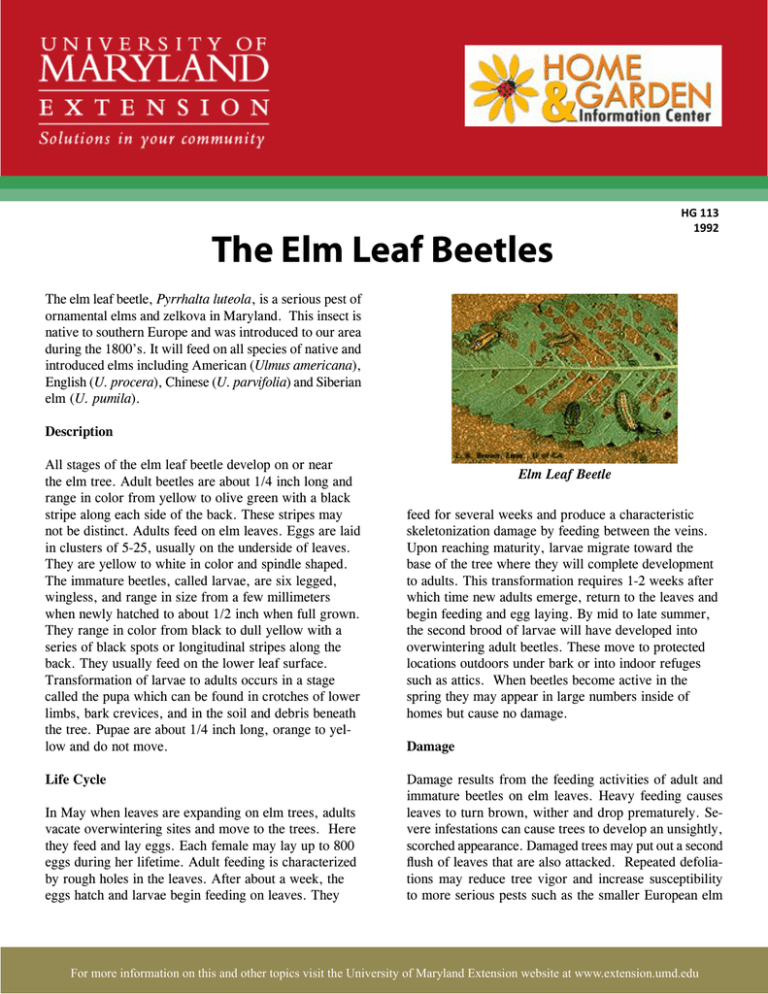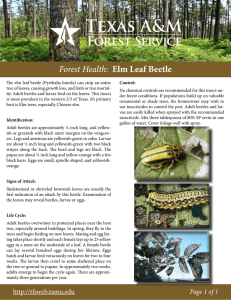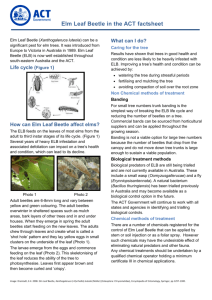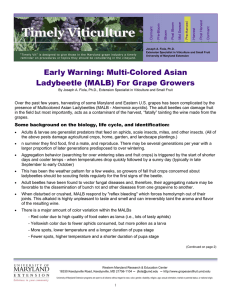The Elm Leaf Beetles
advertisement

The Elm Leaf Beetles HG 113 1992 The elm leaf beetle, Pyrrhalta luteola, is a serious pest of ornamental elms and zelkova in Maryland. This insect is native to southern Europe and was introduced to our area during the 1800’s. It will feed on all species of native and introduced elms including American (Ulmus americana), English (U. procera), Chinese (U. parvifolia) and Siberian elm (U. pumila). Description All stages of the elm leaf beetle develop on or near the elm tree. Adult beetles are about 1/4 inch long and range in color from yellow to olive green with a black stripe along each side of the back. These stripes may not be distinct. Adults feed on elm leaves. Eggs are laid in clusters of 5-25, usually on the underside of leaves. They are yellow to white in color and spindle shaped. The immature beetles, called larvae, are six legged, wingless, and range in size from a few millimeters when newly hatched to about 1/2 inch when full grown. They range in color from black to dull yellow with a series of black spots or longitudinal stripes along the back. They usually feed on the lower leaf surface. Transformation of larvae to adults occurs in a stage called the pupa which can be found in crotches of lower limbs, bark crevices, and in the soil and debris beneath the tree. Pupae are about 1/4 inch long, orange to yellow and do not move. Life Cycle In May when leaves are expanding on elm trees, adults vacate overwintering sites and move to the trees. Here they feed and lay eggs. Each female may lay up to 800 eggs during her lifetime. Adult feeding is characterized by rough holes in the leaves. After about a week, the eggs hatch and larvae begin feeding on leaves. They Elm Leaf Beetle feed for several weeks and produce a characteristic skeletonization damage by feeding between the veins. Upon reaching maturity, larvae migrate toward the base of the tree where they will complete development to adults. This transformation requires 1-2 weeks after which time new adults emerge, return to the leaves and begin feeding and egg laying. By mid to late summer, the second brood of larvae will have developed into overwintering adult beetles. These move to protected locations outdoors under bark or into indoor refuges such as attics. When beetles become active in the spring they may appear in large numbers inside of homes but cause no damage. Damage Damage results from the feeding activities of adult and immature beetles on elm leaves. Heavy feeding causes leaves to turn brown, wither and drop prematurely. Severe infestations can cause trees to develop an unsightly, scorched appearance. Damaged trees may put out a second flush of leaves that are also attacked. Repeated defoliations may reduce tree vigor and increase susceptibility to more serious pests such as the smaller European elm For more information on this and other topics visit the University of Maryland Extension website at www.extension.umd.edu bark beetle which is responsible for spreading the Dutch elm disease fungus. Control Control of this beetle will be most effective when community members cooperate in the use and timing of control measures. This will help reduce the movement of beetles from untreated trees back to treated ones. Sprays should be timed to kill small larvae following egg hatch sometime in mid to late May for the first generation and July to August for the second. M-TRAK® is a biological insecticide (Bacillus thuringiensis var. Tenebrionis) that is effective against the elm leaf beetle larvae. It should be applied when the larvae are small. It is the safest material available to control this beetle. Adult beetles may be excluded from the home by screening, caulking and weatherstripping. Beetles that gain entry may be swept or vacuumed and disposed. Author: Michael J. Raupp, Extension Entomologist, Department of Entomology, University of Maryland, College Park, MD 20742 Revised 5/92: USE INSECTICIDES WITH CARE. READ THE LABEL DIRECTIONS. FOLLOW ALL SAFETY PRECAUTIONS. Mention of trade names in this publication does not constitute an endorsement by Universitiy of Maryland Extension. Do you have a plant or insect pest question? Visit us at extension.umd.edu/hgic and click Ask Maryland’s Garden Experts Author: Mary Kay Malinoski, University of Maryland Extension Specialist, Home and Garden Information Center This publication is a series of publications of the University of Maryland Extension and The Home and Garden Information Center. For more information on related publications and programs, http://extension.umd.edu/hgic. Please visit http://extension.umd.edu/ to find out more about Extension programs in Maryland. The University of Maryland, College of Agriculture and Natural Resources programs are open to all and will not discriminate against anyone because of race, age, sex, color, sexual orientation, physical or mental disability, religion, ancestry, or national origin, marital status, genetic information, or political affiliation, or gender identity and expression. For more information on this and other topics visit the University of Maryland Extension website at www.extension.umd.edu



